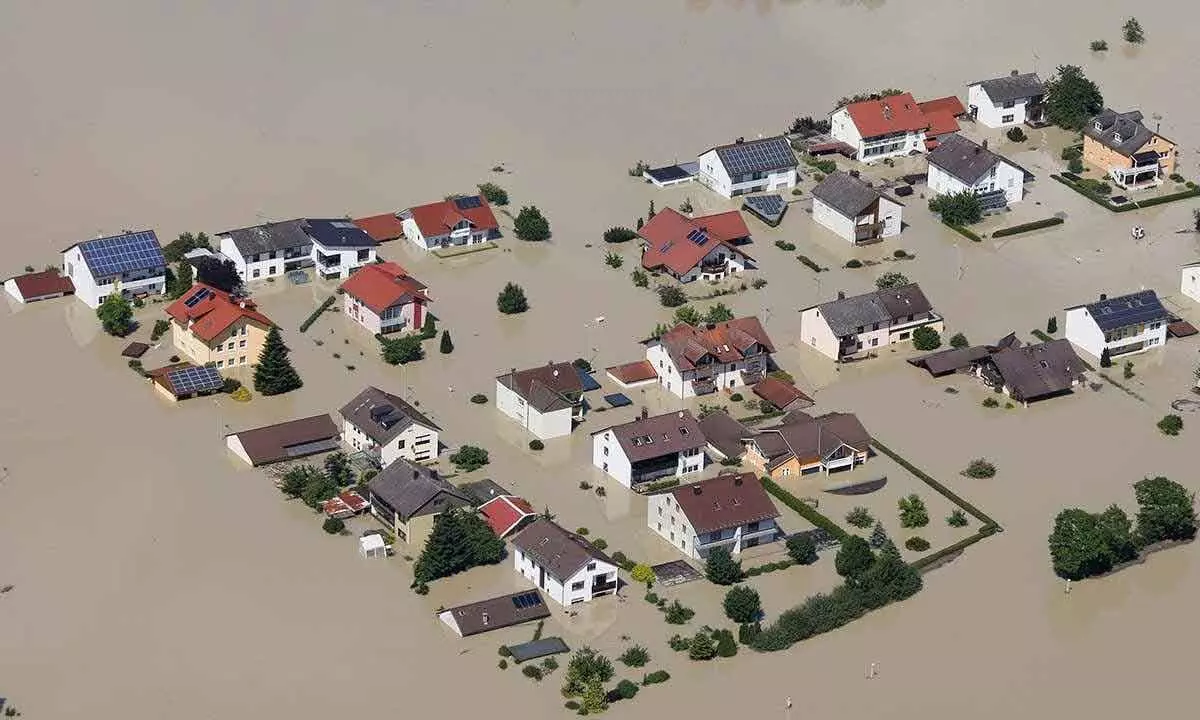Live
- South Sudan targets 300,000 vulnerable people in new cholera vaccination drive
- Lal Bahadur Shastri Death Anniversary 2025: Honouring India’s Second Prime Minister and His Inspiring Words
- Pongal 2025: Celebrating Four Days of Gratitude, Harvest, and Togetherness
- The Countdown Begins: Ramayana: The Legend of Prince Rama Trailer Out Now
- AP to Attract ₹10 Lakh Cr Investment in Green Energy; Chandrababu
- Shiva, Sachin enter quarterfinals of men’s Boxing Nationals
- Clop lacks context, says DIG after video on conception lecture to schoolgirls goes viral
- Kolkata Police investigate Bengal-based NRIs abroad with fake Indian passports
- Chandrababu extends Sankranti greetings to Telugu people
- Piyush Goyal urges cleantech sector to go for self-sustaining innovations
Just In

The number of deaths caused by natural disasters last year rose to 74,000
Berlin: Natural disasters caused losses of around $250 billion across the globe in 2023, German reinsurer Munich Re said in its annual report. Thunderstorms in North America and Europe were “more destructive than ever before”, Xinhua news agency quoted the report as saying.
In North America alone, assets worth around $66 billion dollars were destroyed by storms, while in Europe storm damage amounted to $10 billion. “The warming of the earth that has been accelerating for some years is intensifying the extreme weather in many regions, leading to increasing loss potentials,” said Ernst Rauch, chief climate scientist at Munich Re.
In Germany, 2023 was the warmest year since measurements began in 1881, according to the National Meteorological Service (DWD). In contrast with previous years, which were often characterized by drought and heat waves, 2023 had mostly warm and humid conditions, with high levels of precipitation.
“Climate change is continuing unchecked,” said Tobias Fuchs, head of the climate and environment business area at DWD, when presenting the figures. “We must intensify efforts to protect the climate and learn to adapt to the damage caused by extremes in weather.”
The most devastating natural disaster in 2023 was the earthquakes in southeastern Turkey and Syria in February. Munich Re noted that with 58,000 people killed and overall losses of around $50 billion, it was also the year’s costliest natural disaster. The number of deaths caused by natural disasters last year rose to 74,000. “A series of devastating earthquakes led to humanitarian disasters,” Munich Re said. Around 63,000 people “lost their lives as a result of such geophysical hazards in 2023 - more than at any time since 2010”.
“Comprehensive data and in-depth knowledge of changes in risks remain key factors ... to protect people against natural disasters,” stressed Thomas Blunck, member of the board of management of Munich Re. The most destructive event of the year was a twin earthquake with magnitudes of 7.8 and 7.5 that struck southern Turkey near the Syrian border on February 6. An estimated 14 million people, representing 16 per cent of Turkey’s population, were affected. Confirmed deaths totalled 50,783 in Turkey and 8,476 in Syria.
During the night of May 2, heavy rain pummeled northern and western Rwanda, destroying 5,000 homes and killing at least 129. Flash floods and winds of up to 130 mph from Cyclone Mocha ripped through Myanmar on May 14, causing the deaths of at least 145 people, many of whom belonged to the heavily persecuted Rohingya minority group, according to the Associated Press. On Nov. 3, a 5.6-magnitude earthquake struck western Nepal and killed at least 157 people.
Early May saw torrential rain fall on the eastern region of the Democratic Republic of the Congo, causing flash flooding and mudslides. For six days in early March, heavy rains from Tropical Cyclone Freddy fell upon Malawi and took the lives of at least 679 people, though Malawi President Lazarus Chakwera said the actual toll likely exceeds 1,000.
A 6.3-magnitude quake shook western Afghanistan on October 7, killing at least 1,480 people and injuring thousands more. On September 10, Storm Daniel smashed into the Mediterranean coastal city of Derna in Libya, bringing with it torrential rain and considerable flooding and bursting two of the city’s dams. As of Oct. 31, the official toll sits at 4,352 lives lost, with an estimated 8,000 still missing and feared dead. On February 6, a 7.8-magnitude earthquake struck southeast Turkey near the Syria border, followed by a 7.5-magnitude aftershock mere hours later and multiple other temblors.
As a result, the humanitarian situation in Syria, already afflicted by a host of crises, deteriorated further.

© 2025 Hyderabad Media House Limited/The Hans India. All rights reserved. Powered by hocalwire.com






